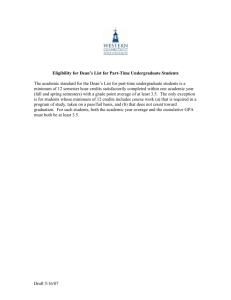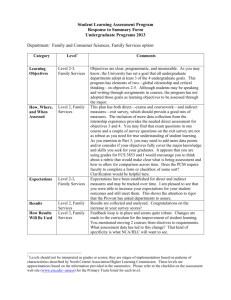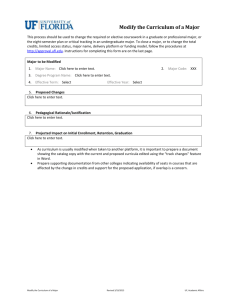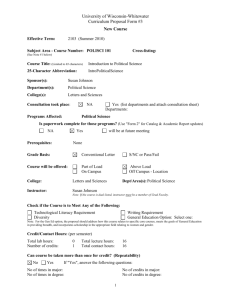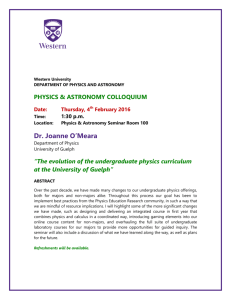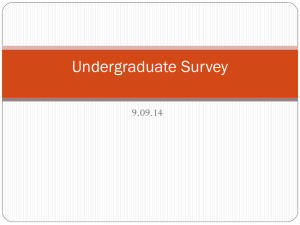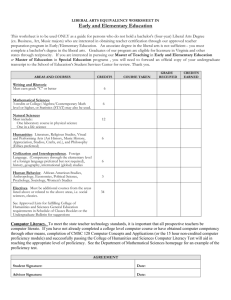Report of the General Education Task Force Fall 2010
advertisement
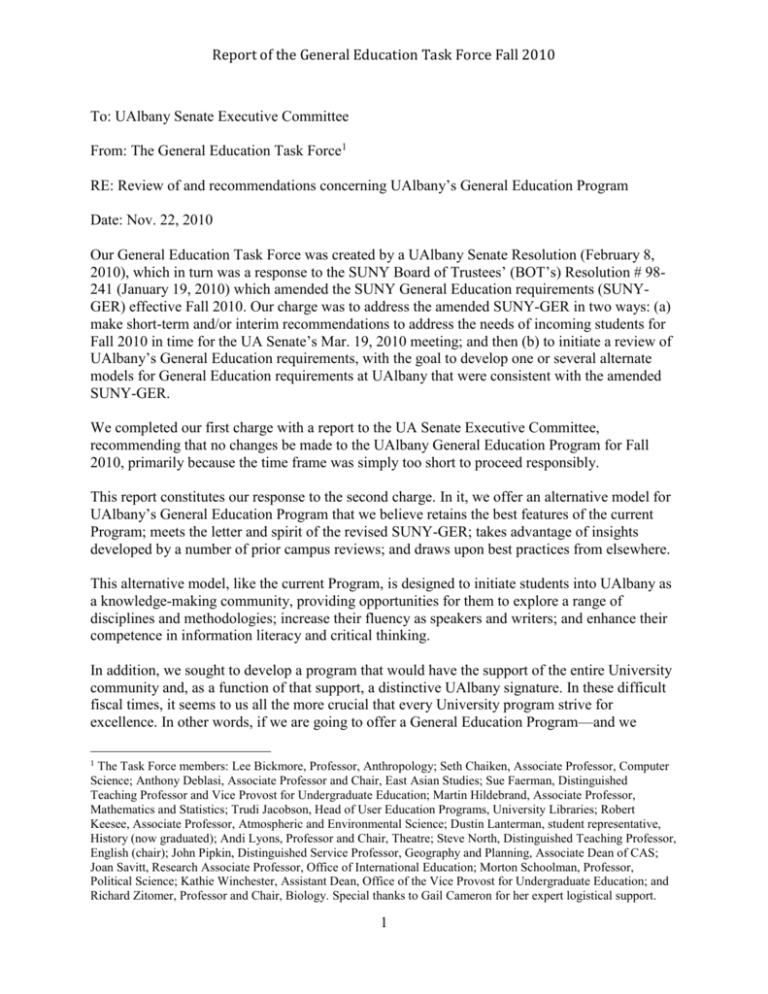
Report of the General Education Task Force Fall 2010 To: UAlbany Senate Executive Committee From: The General Education Task Force1 RE: Review of and recommendations concerning UAlbany’s General Education Program Date: Nov. 22, 2010 Our General Education Task Force was created by a UAlbany Senate Resolution (February 8, 2010), which in turn was a response to the SUNY Board of Trustees’ (BOT’s) Resolution # 98241 (January 19, 2010) which amended the SUNY General Education requirements (SUNYGER) effective Fall 2010. Our charge was to address the amended SUNY-GER in two ways: (a) make short-term and/or interim recommendations to address the needs of incoming students for Fall 2010 in time for the UA Senate’s Mar. 19, 2010 meeting; and then (b) to initiate a review of UAlbany’s General Education requirements, with the goal to develop one or several alternate models for General Education requirements at UAlbany that were consistent with the amended SUNY-GER. We completed our first charge with a report to the UA Senate Executive Committee, recommending that no changes be made to the UAlbany General Education Program for Fall 2010, primarily because the time frame was simply too short to proceed responsibly. This report constitutes our response to the second charge. In it, we offer an alternative model for UAlbany’s General Education Program that we believe retains the best features of the current Program; meets the letter and spirit of the revised SUNY-GER; takes advantage of insights developed by a number of prior campus reviews; and draws upon best practices from elsewhere. This alternative model, like the current Program, is designed to initiate students into UAlbany as a knowledge-making community, providing opportunities for them to explore a range of disciplines and methodologies; increase their fluency as speakers and writers; and enhance their competence in information literacy and critical thinking. In addition, we sought to develop a program that would have the support of the entire University community and, as a function of that support, a distinctive UAlbany signature. In these difficult fiscal times, it seems to us all the more crucial that every University program strive for excellence. In other words, if we are going to offer a General Education Program—and we 1 The Task Force members: Lee Bickmore, Professor, Anthropology; Seth Chaiken, Associate Professor, Computer Science; Anthony Deblasi, Associate Professor and Chair, East Asian Studies; Sue Faerman, Distinguished Teaching Professor and Vice Provost for Undergraduate Education; Martin Hildebrand, Associate Professor, Mathematics and Statistics; Trudi Jacobson, Head of User Education Programs, University Libraries; Robert Keesee, Associate Professor, Atmospheric and Environmental Science; Dustin Lanterman, student representative, History (now graduated); Andi Lyons, Professor and Chair, Theatre; Steve North, Distinguished Teaching Professor, English (chair); John Pipkin, Distinguished Service Professor, Geography and Planning, Associate Dean of CAS; Joan Savitt, Research Associate Professor, Office of International Education; Morton Schoolman, Professor, Political Science; Kathie Winchester, Assistant Dean, Office of the Vice Provost for Undergraduate Education; and Richard Zitomer, Professor and Chair, Biology. Special thanks to Gail Cameron for her expert logistical support. 1 Report of the General Education Task Force Fall 2010 clearly are—then it ought to be a model program, an exemplar, and one that displays our considerable strengths as a faculty. Such a program need not, however, do everything, and in fact we have deliberately constrained our design here to limit the demands it places on the departments that must mount and the students who must complete the University’s wide range of undergraduate majors and minors. Whatever the Program does take on, however, it needs to do well, and to this end we had three additional goals: to streamline the program, reducing the bureaucratic frictions that discourage good-faith participation and erode educational value; to integrate it more fully with instruction in undergraduate majors, especially with regard to developing key competencies; to give it a more explicitly developmental trajectory, with both entry-level courses to help first-year students make the transition into higher education, and upper-division courses that acknowledge the emerging sophistication of juniors and seniors. We are convinced from our own experience and from research on higher education that students’ work in General Education is indispensable for informed citizenship and career success, and that teaching such courses can afford extraordinary satisfaction to faculty. We hope that the plan we are proposing will contribute to a culture change that will be reflected in both student attitudes and the structure of incentives for faculty, and that will lead everyone involved to a just appreciation of the value of our General Education program. The table on page 3 presents the results of our deliberations in schematic form. In the text that follows, we explain each of its components. 2 Report of the General Education Task Force Fall 2010 MANDATED CATEGORIES Mathematics and Statistics: NUMBER OF CREDITS 3 One semester of collegiate study or the equivalent of mathematics at or above the level of pre-calculus and/or probability, statistics, and data analysis Writing: 3 One semester in EITHER Introduction to Writing in the University OR the First-Year Seminar FLEXIBLE CATEGORIES Arts and Humanities 3 One semester of collegiate study in an approved course in the Arts or Humanities Natural Sciences 3 One semester of collegiate study in an approved course in the Natural Sciences Social Sciences 3 One semester of collegiate study in an approved course in the Social Sciences Historical, Global and Regional Studies: 3 One semester of collegiate study, or the equivalent, in a course from EITHER U.S. Historical Perspectives OR Europe OR Regions beyond Europe Foreign Language: 6* Completion of second semester of an approved language other than English LOCAL REQUIREMENTS The World Within Reach: Global Challenges in the 21st Century 6 Two semesters of collegiate study in approved World Within Reach courses Prerequisites: 15 crs General Education, incl 3 Arts/Hum, 3 Nat. Sci., 3 Soc.Sci. TOTAL CREDITS IN GENERAL EDUCATION COURSES 30 REQUIRED COMPETENCIES MET IN UALBANY MAJORS Oral Discourse: N/A** Successful completion of designated course or courses in the major Information Literacy N/A Successful completion of designated course or courses in the major Critical Thinking N/A Successful completion of designated course or courses in the major Upper Level Writing Course N/A Successful completion of designated course or courses in the major designed to develop proficiency in writing in the genres appropriate to the major’s discipline *Credits for the Foreign Language Requirement represent a minimum number for a student to complete the second semester course if he or she has not yet begun study of that language. Credits per course vary by language and therefore the individual experiences of the students will vary. **Credits are not given for requirements met in the course of completing a major since those credits are not confined to the General Education program. 3 Report of the General Education Task Force Fall 2010 MANDATED CATEGORIES2 Mathematics and Statistics Approved courses would introduce students to or extend their knowledge of pre-calculus, calculus, discrete mathematics, probability, statistics and/or data analysis. Such courses may be offered by the Department of Mathematics and Statistics, but also in other departments that have expertise in quantitative reasoning and data analysis and that offer appropriate courses, particularly in statistics or discrete structures. Writing The Lower-Division Writing Intensive requirement would be amended so that it can be satisfied only by Introduction to Writing in the University; the First-Year Seminar; or an approved firstyear writing course that provides direct instruction in argumentative academic writing. Introduction to Writing in the University would be offered by the University Writing Program described in the report of the Writing Task Force (2007), and subsequently endorsed by the Moving Forward Plan, the Middle States Self-Study, and the Strategic Planning Committee’s Task Force on Undergraduate Education. As the course’s title suggests, it would provide an introduction to the demands of post-secondary writing, and thereby provide students with a point of departure for subsequent instruction in their undergraduate majors and minors. The Freshman Seminar, meanwhile, was recommended by the Strategic Planning Committee’s Task Force on Undergraduate Education, which in turn endorsed it because of the success such seminars have enjoyed elsewhere—a best practice—and as a response to UAlbany’s chronic inability to provide native students seats in small, lower-division courses. Educational research suggests that there is a strong correlation between the availability of such courses and high rates of retention.3 In keeping with those findings, UAlbany’s ranking in surveys such as that offered by U.S. News and World Report has consistently suffered because the University offers too many large courses and too few small ones. As per the Strategic Plan’s recommendation, then, all departments would be asked to offer each year a limited (1-3) but equitable number of small (<25), freshman-only courses (i.e., Freshman Seminars), all taught by full-time teaching faculty or other appropriately qualified full-time employees. Faculty teaching these courses would receive support in designing and offering courses for this population. Freshman Seminars would be designed to include a substantial amount of writing and therefore would qualify as writing courses under the General Education program. Ideally, all native freshmen would have access to both Freshman Seminars and Introduction to Writing in the University courses. In deference to the extraordinary fiscal constraints the 2 The revised SUNY-GER mandates that while campuses have greater flexibility regarding most requirements, all SUNY students must complete those in Mathematics and Statistics, and Basic Communication (which comprises both written and oral discourse). See, e.g., C. Schnell and C. Doetkott, “First Year Seminars Produce Long Term Impact.” Journal of College Student Retention: Research, Theory and Practice. Vol. 4 (4), 2002-2003: 377-91. 3 4 Report of the General Education Task Force Fall 2010 University faces, however, we are proposing, as a starting point, that all native students have access to one course or the other in their first year. (Accommodating 2000 native freshmen per year would require about 50 sections of these courses per semester in some combination: e.g., 25 Introduction to Writing in the University + 20 Freshman Seminars + 5 approved writing courses.) Advantages: In addition to what we believe are its substantial educational advantages, this approach to the Writing Requirement greatly streamlines both departmental offerings in this category (no more crazy quilt of Lower-Division WI courses) and students’ selection processes (eliminating the T, V, W and Z suffixes that indicate whether a course fulfills the Writing Intensive and/or other competency requirements). Developmentally, it represents the necessary first step toward creating a clear trajectory through the General Education Program. And last but far from least, it would distinguish UAlbany’s General Education Program, from the outset, as the first of the SUNY Research Centers to offer Freshman Seminars taught by full-time faculty on anything like this scale. FLEXIBLE CATEGORIES4 Disciplinary Perspectives The aim of the requirement in this category is to help students begin their exploration of the fields, disciplines and methodologies that comprise the University as a knowledge-making community. To that end, they are required to satisfactorily complete at least one Natural Science, Social Science, and Arts/Humanities course. Many students will go on to take additional classes in these categories (as part of their undergraduate majors or minors, or as electives), but these required courses will get them started. Advantages: This approach streamlines the Program by reducing the total number of requirements. In addition, by combining the Arts and Humanities categories, it eliminates the current bureaucratic (as opposed to educational) rule that prohibits students from using a single course to satisfy the Arts and the Humanities requirement—even if that course qualifies in both categories. Historical, Global and Regional Studies As with Disciplinary Perspectives, this category is designed to get students to begin exploring the University’s constituent fields, disciplines and methodologies, in this case with a more pronounced topical orientation. To that end, it requires that they select a course that covers one of the following three areas: U.S. History5, Europe, or Regions beyond Europe. In this category, 4 The revised SUNY-GER requires that, in addition to meeting requirements in the two mandated categories, students earn a minimum of 30 credits in at least 5 of these other 8 categories: Natural Sciences, Social Sciences, The Arts, Humanities, American History (UA’s “U.S. History”), Western Civilization (UA’s “Europe”), Other World Civilizations (UA’s “Regions Beyond Europe”), and Foreign Language. 5 In keeping with the SUNY-GER, the U.S. Historical Perspectives category here features an emphasis on both topical focus and chronological breadth. However, students who score 85 or above on the Regents Examination in “United States History and Government” will be considered to have fulfilled the chronological breadth criterion. Should such students opt for the U.S. Historical Perspectives category, therefore, they will be eligible to choose from EITHER the basic list available to all students OR from a list of more specialized courses. 5 Report of the General Education Task Force Fall 2010 as well, many students will go on to take additional classes as part of their undergraduate majors or minors, or as electives, but their required courses will get them started. Advantages: As with our approach to Disciplinary Perspectives, this arrangement streamlines the Program by reducing the total number of requirements. In addition, it eases the problems created for students by the periodic scarcity of seats in the Regions beyond Europe category. Foreign Language The goal of this requirement, too, is to encourage students to explore the University as a knowledge-making community. We want to emphasize, however, our conviction that providing ready and universal access to such language study is central to the mission of a public university. In addition to its extensively documented intellectual benefits, such study also opens up, or keeps open, a wide range of opportunities for our students—and at a time in their lives when many of them are not in a position to realize what those opportunities might be.6 Accordingly, students would be required to demonstrate basic proficiency in the understanding and use of an ancient or modern human language other than English. Those who fulfill their SUNY-GER after matriculating at UAlbany must do so by satisfactorily completing the second college semester—Elementary II—in the study of a foreign language or an approved equivalent.7 Departments which offer approved courses in these languages must make provision for students to enroll in some version of the first-semester course—Elementary I—regardless of any prior instruction such students may have received in the target language. Advantages: This is not significantly different from current practice, but it does improve student access to Elementary I in languages they may have studied in high school. COMPETENCIES Oral Discourse This requirement would be integrated into each major. Accordingly, all units offering an undergraduate major would be required to certify the means (e.g., a specific course, a sequence See, e.g., the American Council on the Teaching of Foreign Languages website on “What the Research Shows” at http://www.actfl.org/i4a/pages/index.cfm?pageid=4524 6 7 There are five such equivalents: (1) taking an approved course equivalent to Elementary II at another accredited college or university; (2) passing a Regents “Checkpoint B” Examination or a Regents’ approved equivalent examination with a score of 85 or above; (3) demonstrating competency in a language other than English, including languages not currently offered for formal instruction at this University; (4) participating in a study-abroad program of any length, and successfully completing therein at least 6 SUNY credits of language in any of the official languages of the host country other than English; and (5) participating in a study-abroad program of at least one full semester, and successfully completing therein at least 3 SUNY credits of language instruction in any of the official languages of the host country other than English. 6 Report of the General Education Task Force Fall 2010 of courses) by which students in that major would meet the learning outcomes for this requirement. The educational logic of this arrangement is straightforward: students working in their major fields have the kind of sustained engagement with both subject matter (what to say) and discursive practices (how to say it) that provide by far the best occasions for them to engage in and learn about disciplined speaking. Advantages: This approach is not significantly different from actual current practice. Students now meet the “Oral Discourse” requirement mainly by taking designated upper-division courses in their undergraduate majors. This change simply formalizes that practice, and at the same time streamlines the enrollment process for students by eliminating the T, U, W and Y suffixes that indicate whether a course fulfills the Oral Discourse and/or other competency requirements. Information Literacy This requirement, like Oral Discourse, will be integrated into each major, and for similar reasons. That is, while students can and should be given a basic introduction to information literacy early in their careers—in, for example, Introduction to Writing in the University, the Freshman Seminar, or UNL 205/206—the sustained engagement with both subject matter and methodology that comprise work in their major fields will provide by far the best context for their acquisition of a genuine information literacy.8 Accordingly, all units offering an undergraduate major would be required to certify the means (e.g., a specific course, a sequence of courses) by which students in that major would meet the learning outcomes for this requirement. Advantages: In addition to its educational advantages, this approach to the Information Literacy requirement would substantially streamline the means by which students meet it. At present, very few departments offer any courses in this category at all,9 with the result that students often have trouble finding seats, and end up meeting the requirement late in their careers. As an added benefit, this approach eliminates another four suffixes (T, U, V, and X) that indicate whether a course fulfills the Information Literacy and/or other competency requirements. Critical Thinking This requirement, like Oral Discourse and Information Literacy, will be integrated into each major. That is, while students can and should be given an introduction to critical thinking in other General Education courses, the sustained engagement with both subject matter and methodology that comprise work in their major fields will provide by far the best occasion for disciplined critical thinking. 8 So, e.g., in Developing Research & Communication Skills: Guidelines for Information Literacy in the Curriculum (2003), the Middle States Commission on Higher Education notes that “weaving information literacy explicitly into specific disciplines enables students to place the essential skills in the context of their majors, because each discipline has its unique approach to information, critical thinking, and evaluation” (3). 9 For Fall 2010, e.g., fewer than 10 units listed any such undergraduate courses. 7 Report of the General Education Task Force Fall 2010 Accordingly, all units offering an undergraduate major would be required to certify the means (e.g., a specific course, a sequence of courses) by which students in that major would meet the learning outcomes for this requirement. Advantages: This approach essentially formalizes current practice. LOCAL REQUIREMENTS The World Within Reach: Global Challenges in the Twenty-First Century10 Approved courses in this signature UAlbany category will be designed expressly for upperdivision students (300-level or above), and focus on the challenges facing our global society in the 21st century as those challenges are defined by any and all of the University’s constituent disciplines. These courses will present material of a complexity and in a depth appropriate to the considerable sophistication of juniors and seniors. To make these courses accessible to all upper-level students, their only prerequisites will be successful completion of the Disciplinary Perspectives requirements and at least 15 General Education credits in total. In addition, students who have declared only one major must take at least one of their two World Within Reach (WWR) courses outside that major. Advisors would accordingly urge most students to wait to enroll in such courses until at least their junior year. All departments will be required to offer such courses at a frequency and of a capacity appropriate to the number of their faculty. The specific configuration of sections—i.e., lecture, small class, etc.—would be up to departments. Departments would also determine how and/or whether such courses counted toward students’ undergraduate majors or minors. Advantages: This approach has a number of advantages. First, from an educational perspective these courses give the General Education Program as a whole a much more pronounced developmental trajectory, providing an upper-division counterpart to the entry-level courses (Freshman Seminars, Introduction to Writing in the University) that recognizes students’ intellectual maturation, and thereby serves as a kind of capstone to the Program’s overall goals of helping students to situate themselves in a global economy and preparing for lives as informed and socially responsible citizens.11 The SUNY Provost’s memorandum, “Policy and Guidance: State University General Education Requirement” (May 28, 2010), affords campuses the option of developing Local General Education Requirements designed to “add specificity to the SUNY-GER” (1). These requirements are designed to do just that. 10 It is worth noting here that in aid of the Task Force’s efforts, UAlbany applied to and was accepted for the American Association of Colleges and Universities’ (AAC&U) Curriculum and Faculty Development Project, “General Education for a Global Century.” Over 140 institutions applied, and only 32 were accepted, and we are certain that one of the strengths of our proposal was precisely this developmental dimension. Applicants were expected to develop “a first to final year structure—keyed to expected student capabilities rather than specified course content—with integrative and applied work at milestone and culminating points across the curriculum, and flexible points of entry for transfer students.” See http://www.aacu.org/SharedFutures/global_century/ 11 8 Report of the General Education Task Force Fall 2010 Second, it will encourage a much broader range of departments to participate in the LocalRequirements portion of the General Education Program than do so under U.S. Diversity and Pluralism (USDP) and Global and Cross-Cultural Perspectives (GCCP),12 but without displacing the units which do participate therein. Indeed, the kinds of topics covered in many current USDP and GCCP courses could quite readily be revised as WWR courses.13 Students would thus have access to a much wider range of choices. Third, this model explicitly serves the University’s overall efforts at cohort building by bringing together all students for a shared experience. These courses would also help transfers, especially, in identifying an appropriate minor by giving them a ready-made vehicle for exploring new territory. Last but not least, the World Within Reach courses give the General Education Program another innovative and distinctive UAlbany signature, providing students access to the University’s most accomplished faculty at a time in their undergraduate careers when they are best equipped to make the most of it. The Upper-Division Writing Intensive Requirement All departments offering undergraduate majors must offer, as part of that major, a mandatory second- or early third-year course (200-300 level) explicitly designed to teach disciplinary writing appropriate to the sponsoring field (i.e., Psychology, History, Biology, etc.). This requirement follows the recommendation of the Undergraduate Education Task Force of the Strategic Planning Committee. Once again, the educational logic is clear: the general introduction to college-level writing in the Freshman Seminar or first-year writing course will necessarily be pre- or proto-disciplinary, since the students will not yet know enough about any field for it to be otherwise. When students subsequently do choose a major field of study, they will need to be taught the specific genres, conventions and modes of argument central to communicating ideas in that field. Administratively, the requirement for such a course should not be narrowly considered as part of the General Education Program. Rather, writing would be a regular feature of all the majors accredited by the University faculty for inclusion in its curriculum, with standards established and maintained by that faculty. If the University Senate were to approve such a requirement, and the President to endorse it, oversight might best be located in the Undergraduate Academic Council itself or a subcommittee tasked with coordination of the writing program as a whole (and not, therefore, with UAC’s more focused General Education Committee and/or the Associate Dean for Undergraduate Education). 12 The Fall 2010 schedule, e.g., features 64 and 57 courses in USDP and GCCP, respectively, offered by 17 and 15 units (including, in both cases, CAS and/or UNI listings). 13 Under GCCP, e.g., courses like AGOG 225, World Cities, or APHI 214, World Religions, might be recast as World Cities or World Religions in the 21st Century. Under USDP, courses like AAAS 213, History of the Civil Rights Movement or ACLS 282, Race and Ethnicity, might similarly be recast as The Civil Rights Movement or Race and Ethnicity in the 21st Century (both with a still significant historical component). 9 Report of the General Education Task Force Fall 2010 If, however, the Senate cannot approve such a requirement, we would recommend leaving the current Upper Division Writing Intensive requirement in place until such time as there is a viable alternative. Advantages: This course provides the crucial centerpiece for a trio of courses envisioned in the Strategic Plan—a trio designed specifically to give students a coherent developmental trajectory as writers through their college years: a first-year writing course and/or Freshman Seminar; the course described here, which introduces the modes of writing in students’ chosen fields; and the capstone course, where they bring to bear all of what they have learned in substantive, methodological and rhetorical terms. They may well do much writing in other courses—we certainly hope so—but these three courses will feature writing as writing in a particularly selfconscious way. In addition, if, as per our recommendation, such a course becomes a standard feature of all majors—and not, that is, a General Education requirement—it will help departments focus their WI energies more effectively, and make students’ lives simpler by eliminating the current system of suffixes indicating how many requirements a course might fulfill in addition to the WI requirement. THE TASK FORCE PROPOSAL AND THE BOT SUNY-GER MANDATE The revised SUNY-GER requires that (a) students must complete work in two mandated categories, Mathematics and Basic Communication; (b) complete work in at least 5 of an additional 8 categories, Natural Sciences, Social Sciences, the Arts, Humanities, American History (UA’s “U.S. History”), Western Civilization (UA’s “Europe”), Other World Civilizations (UA’s “Regions Beyond Europe”), Foreign Language; (c) demonstrate competence in Critical Thinking and Information Literacy; and (d) earn a minimum of 30 General Education credits overall. The program proposed here ensures that all UAlbany graduates will have satisfied (a) by satisfactorily completing UAlbany’s 3-credit Mathematics requirement, along with the combination of the 3-credit requirement in a lower-division writing course plus the required Oral Discourse component integrated within the majors. It ensures that they will have met (b) by requiring them to satisfactorily complete at least 3 credits each in Art/Humanities, Social Sciences, Natural Sciences, and Historical, Cultural, and Regional (HCR) Perspectives, plus the second semester of a Foreign Language. In other words, regardless of how students choose courses within the Arts/Humanities and HCR Perspectives categories, they will meet the 5 of 8 mandate. It ensures that they will have met (c), the Information Literacy and Critical Thinking competencies, by fulfilling the requisite requirements of their majors in those areas. As for (d), the 30-credit minimum: For many students, successfully completing the local 6-credit, World-Within-Reach requirement will bring their overall total of General Education credits to 30. Students who do not reach that total—primarily those who matriculate having already 10 Report of the General Education Task Force Fall 2010 satisfied the Foreign Language requirement—will have earned the option to choose whichever additional General Education course(s) best suit their individual academic programs and raise their credit total to the required 30. IMPLEMENTING AND ADMINISTERING THE GENERAL EDUCATION PROGRAM We have two recommendations concerning the implementation and administration of the Program we propose here. First, we believe that no changes should be made to the current Program until a full-fledged counterpart is fully in place. In short, no student should be disadvantaged by any programmatic transition. Second, and as a complement to the current University Governance structures charged with oversight of the General Education Program, we recommend the creation of an Advisory Board. This body should be chaired by the Associate Dean for General Education and include up to twenty (20) instructors (teaching faculty and part-time/adjunct faculty), with at least one person from each of the different categories of the General Education requirements, and up to five (5) undergraduate students from different undergraduate majors. Membership on this Board should not only be representative of the different categories of General Education courses, but should also appropriately represent the academic units responsible for teaching courses in the General Education program. In addition, each year, the Advisory Board will request that the Undergraduate Academic Council (UAC) appoint one member to serve as a liaison between the Advisory Board and the UAC. Members of the General Education Advisory Board shall serve a three-year term, which may be renewed once, but initially some members will be appointed on a one- and two-year basis to allow for continuity as well as rotation. The Governance Council of the University Senate will be asked each year Spring to nominate individuals for terms beginning the following academic year. Appointments will be made jointly by the Provost and the Vice Provost for Undergraduate Education. The Advisory Board would not be a policy-making body, but would play a proactive ongoing role in the effort to conceptualize a General Education program that is relevant to the current realities of the University at Albany as changes occur in the academic and intellectual environment of higher education. It would be responsible for ensuring that the principles and practices of the General Education program are well understood by all stakeholders, so that all concerned parties understand that General Education courses are an integral part of undergraduate work. In this context, the Advisory Board would be responsible for soliciting student input on an ongoing basis about desirable General Education courses; working with deans and department chairs to find support for faculty to design and teach such courses; and to carry on such work with all constituencies, particularly in developing the World Within Reach courses in a way that recognizes the varying contributions different departments and programs can make to the General Education program overall. The General Education Advisory Board and, in particular, the Associate Dean, would be responsible for publicizing the General Education program to new faculty and incoming 11 Report of the General Education Task Force Fall 2010 students, and for helping these newcomers understand such processes as proposing new courses and seeking waivers for particular requirements. UAC, meanwhile, would continue in its role of shaping and reviewing the University’s academic policy as a whole, with its General Education Committee, in particular, reviewing both proposed and revised courses submitted for possible inclusion in the General Education Program, as well as student requests for waivers and substitutions. 12 Report of the General Education Task Force Fall 2010 APPENDIX A COMPARISON TO CURRENT PROGRAM As we explained in our introduction, the model we are proposing is designed to limit the demands it places on the departments which must mount and students who must take the University’s wide range of undergraduate majors and minors. We commented on some of those limits in the proposal itself, but believe it useful to lay them out explicitly here, and specifically in relation to the demands of the current program. Making a comparison from the students’ perspective is not a simple matter, since our students enter the University with a highly variable number of credits in hand, and because they are allowed to use some courses to satisfy more than one General Education requirement (so-called double-counting). Still, a student who enrolls under the current program with no requirements yet met, and who subsequently takes no advantage of double-counting, faces the set of requirements in the left column, while a student in the proposed program would face those in the right: Min. Credits Arts 3 Humanities 3 Natural Sciences 6 Social Sciences 6 U.S. Historical Perspective 3 Europe 3 Regions Beyond Europe 3 Global and Cross-Cultural Studies 3 U.S. Diversity and Pluralism 3 Mathematics 3 Foreign Language 6* Lower-level Writing min. 1 course Upper-level Writing min. 1 course Oral Discourse min. 1 course Information Literacy min. 1 course TOTAL: Arts OR Humanities 42 + 4 approved courses Min. Credits 3 Natural Sciences Social Sciences U.S. Historical Pers. OR Europe OR Regs. Beyond Eur. World Within Reach 3 3 Mathematics Foreign Language Lower-level Writing Upper-level Writing Oral Discourse Information Literacy 3 6* 3 Instruction in major Instruction in major Instruction in major 3 6 30 + 3 Instruction in major *Six credits is the minimum needed to complete the second semester of a foreign language if a student begins that language with no previous experience. Overall, in other words, students in the proposed program would be provided a guaranteed a seat in a small, first-year writing-intensive course instead of having to locate a Lower-Division WI seat; would automatically fulfill the Upper-Level Writing, Oral Discourse and Information Literacy requirements in the process of completing their majors, instead of having to fulfill each independently; and would be required to earn 12 fewer credits in General Education courses overall. 13 Report of the General Education Task Force Fall 2010 Calculating a comparison of the General Education burden from a departmental perspective is also complicated, primarily because the various differences do not affect departments in uniform ways. However, cast simply in terms of the minimum total seats the General Education Program requires for incoming classes of 2000 students to earn all their minimum credits (i.e., to accommodate them in the same scenario as above), it looks like this: Min. Seats/Year Arts Humanities Natural Sciences Social Sciences U.S. Historical Perspective Europe Regions Beyond Europe Global and Cross-Cultural Pers. U.S. Diversity and Pluralism Mathematics Foreign Language Lower-level Writing Upper-level Writing Oral Discourse Information Literacy 2000 2000 4000 4000 2000 2000 2000 2000 2000 2000 4000 2000 2000 2000 2000 TOTAL: 36,000 Min. Seats/Year Arts OR Humanities 2000 Natural Sciences Social Sciences U.S. Historical Pers. OR Europe OR Regs. Beyond Eur. World Within Reach 2000 2000 2000 4000 Mathematics Foreign Language Lower-level Writing Upper-level Writing Oral Discourse Information Literacy 2000 4000 1000* 2000** 2000** 2000** 25,000 * Assumes that the University Writing Program would mount half the sections required, with the other half provided by Freshman Seminars mounted in the departments. **Under this model, these three requirements would be made coterminous with major requirements, and would therefore have less of an impact on total seat count than these figures might otherwise suggest. The model we are proposing, in other words, requires departments to generate some 30% fewer General Education seats per year than does the current Program. In addition, it deploys the University’s collective resources more effectively in two ways. First, as the note for the double-asterisked items in the table indicates, the requirements for UpperLevel Writing, Oral Discourse, and Information Literacy are coterminous with, and therefore fully integrated into, each major, which means that no additional resources would be needed to provide for such requirements elsewhere, as they are now. Second, the design of the World Within Reach requirement will require the participation of all departments. This will free the relatively small number of units currently handling nearly all of the Program’s Local Requirements from the distorting effects of that burden on their deployment of resources, thereby allowing them to operate more efficiently. A full comparison of the requirements for SUNY-GER, UAlbany’s current Program, and the proposed program is laid out in the table below: 14 Report of the General Education Task Force Fall 2010 COMPARATIVE TABLE: REVISED SUNY-GER, UA CURRENT, AND POSSIBLE PROPOSALS REQUIRED KNOWLEDGE AND SKILL AREAS Category SUNY-GER Math&Stats 1 course or > 85 on Regents . Basic Comm:14 Writing Oral Disc. UA Current 3 in pre-Calc,Calc or Stats Regents Math B> 85, or other approved course Task Force Proposal 3 in pre-Calc, Calc, Stats or other approved course 1 course 1-3 in LD WI course in FY or Soph Coupled with writing 1 approved course 3 crs in FY Intro to Writing OR Freshman Seminar OR approved FY writing course Fulfilled in each major as per SUNYGER guidelines15 FLEXIBLE KNOWLEDGE AND SKILL AREAS SUNY-GER Category (Possible) 3 Natural Science (Possible) 3 Social Science (Possible) 3 Humanities UA Current Task Force Proposal 6 3 6 3 3 3 credits in Humanities OR Arts 3 credits in Humanities OR Arts 3 in Am. History, basic intro. or spec. course w/Regents > 85 OR 3 in Europe OR 3 in Regions beyond Europe 2nd semester (Elem. II) UA course; or Regents >85; or demonstrated competency; or app. study-abroad work Arts (Possible) 3 3 Am. History16 (Possible) 3 in Am. History, basic intro. or spec. course w/Regents > 85 (Possible) 3 3 in Am. History, basic intro. or spec. course w/Regents > 85 AND 3 in Europe AND 3 in Regions beyond Europe 2nd semester (Elem. II) UA course; or Regents >85; or 1 non-UA Course; or demonstrated competency; or app. study-abroad work Other World Civ (Possible) 3 Foreign Lang (Possible) one course or Regents >85 14 The BOT SUNY-GER Basic Communication requires proficiency in writing and oral communication. The table therefore breaks this requirement into its component parts. “Campuses proposing to cover the Basic Communication outcomes by diffusion . . . must demonstrate that they are taught and practiced in all the courses involved. This demonstration may be facilitated by describing the mechanisms of course or program organization for achieving the learning outcomes.” From “Guidelines for the Approval of State University General Education Requirement Courses,” p. 5. Office of the Provost, System Administration. May 4, 2001. Amended April 13, 2005. 15 16 The Task Force Proposal groups the three categories of American History, Western Civilization, and Other World Civilizations as one category from which students must take a single course. 15 Report of the General Education Task Force Fall 2010 COMPETENCIES Info Mgmt SUNY-GER Need not be coursespecific Critical Thinking Need not be coursespecific LOCAL REQUIREMENTS U.D. Writing Int. None *U.S. Diversity *Global/ Cross-Cultural World Within Reach None None None UA Current 1 approved course in more demanding Info Literacy category Not course-specific Task Force Proposal Fulfilled in major as per SUNY-GER guidelines17 1-4 in approved 300-level or above 3 in approved course 3 in approved course None Required course in major Fulfilled in major as per SUNY-GER guidelines None None 6 in approved courses18 17“The Critical Thinking and Information Management competencies are not necessarily associated with any one course, though either or both of them could be imparted in specific “Critical Thinking” or “Information Management” courses. In either case, campus submissions must demonstrate that the learning outcomes are accomplished in the overall undergraduate curriculum.” From “Guidelines for the Approval of State University General Education Requirement Courses,” p. 6. Office of the Provost, System Administration. May 4, 2001. Amended April 13, 2005. 18 Prerequisite: successful completion of 15 General Education credits including Disciplinary Perspectives. 16
